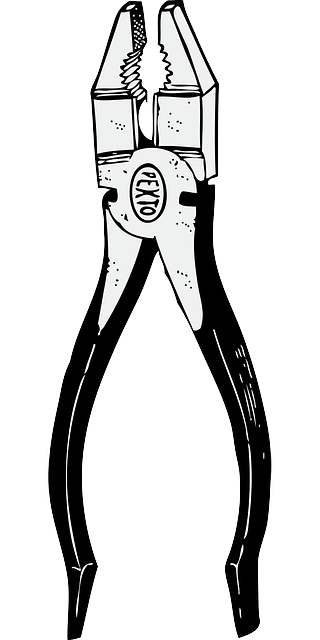Revolutionizing Auto Care: The Rise of Pickup and Delivery for Convenient Body Repair
In today's fast-paced world, convenient auto body repair services are transforming car maintena…….
Welcome to an in-depth exploration of a transforming industry—Convenient Auto Body Repair. In today’s fast-paced world, where time is a precious commodity, the concept of accessible and efficient vehicle body maintenance has gained significant traction. This article aims to dissect and demystify what constitutes convenient auto body repair, its global impact, and the numerous factors influencing its evolution. By the end, readers will grasp the profound implications and opportunities this field presents in an increasingly digital age.
Definition: Convenient auto body repair refers to a modern approach to vehicle damage restoration, emphasizing accessibility, speed, and customer-centric services. It involves a range of techniques and technologies designed to streamline the traditional repair process, making it more efficient and less disruptive to customers’ daily lives.
At its core, this concept revolves around three key pillars:
Accessibility: Providing repair services in convenient locations, such as mobile units, dedicated workshops, or even through pop-up shops, ensuring that customers can access repairs without significant travel or appointment waiting times.
Speed and Efficiency: Utilizing advanced technologies, streamlined processes, and well-trained personnel to minimize the time required for body repairs. This includes rapid diagnostics, efficient parts replacement, and optimized work flows.
Customer Experience: Prioritizing customer satisfaction by offering transparent pricing, personalized services, and convenient payment options. Effective communication, flexible scheduling, and post-repair follow-ups contribute to an exceptional customer journey.
Historical Context: The concept of convenient auto body repair has evolved over the past few decades, driven by changing consumer expectations and technological advancements. Historically, vehicle repairs were often a time-consuming affair, requiring owners to visit dealerships or specialized workshops, wait for parts, and endure lengthy repair times. However, with the rise of mobile technologies, online services, and a customer-centric mindset, this landscape is rapidly transforming.
Significance: In an era where convenience and time-saving measures are highly valued, convenient auto body repair offers several advantages:
Time Efficiency: Customers can get their vehicles repaired quickly without sacrificing work or personal commitments.
Cost-Effectiveness: Streamlined processes often lead to reduced labor costs, potentially lower repair bills, and fewer out-of-pocket expenses for customers.
Convenience: Accessing repair services from convenient locations or through online platforms enhances customer flexibility and satisfaction.
Safety and Roadside Assistance: Quick repairs, especially for critical safety components, ensure safer vehicles on the road and contribute to roadside assistance programs.
The concept of convenient auto body repair has spread globally, adapting to diverse cultural and regional contexts. Key trends shaping this industry include:
Urbanization and Mobile Repair Services: In densely populated cities, mobile repair units are becoming increasingly popular. These services allow technicians to visit customers at their locations, providing convenience and reducing the need for long trips to workshops.
Online Booking and Digital Platforms: The rise of digital platforms enables customers to book repairs online, receive quotes, and track progress in real time. This trend is particularly prominent in regions with high internet penetration rates.
Regional Variations: Different countries embrace convenient auto body repair at varying speeds. For instance, North America and Western Europe have seen early adoption, while markets in Asia Pacific and Latin America are witnessing growing interest as infrastructure improves.
Sustainability Focus: Many regions are incorporating eco-friendly practices, such as using biodegradable materials for repairs, promoting recycling, and adopting electric repair equipment, aligning with global sustainability goals.
The convenient auto body repair market is a significant contributor to the global automotive industry, with several economic factors at play:
| Market Dynamics | Impact |
|---|---|
| Increasing Vehicle Ownership: Rising disposable incomes in developing nations lead to higher vehicle ownership, creating a larger customer base for convenient auto body repair services. | Expands market potential and drives industry growth. |
| Urbanization: As cities grow, the demand for mobile and quick-turnaround repairs increases, presenting numerous business opportunities. | Encourages the proliferation of specialized mobile units and workshops in urban areas. |
| Competitive Pricing: Customers increasingly compare prices online, leading to more competitive pricing strategies among repair providers. | Forces businesses to optimize processes, potentially lowering costs and attracting price-conscious consumers. |
| Partnerships and Collaborations: Repair shops and insurance companies collaborate to streamline claims processing, offering bundled services for customers. | Enhances customer convenience and improves the efficiency of claims settlements. |
Investment Patterns: The industry attracts investments from venture capitalists, private equity firms, and established automotive players. Startups focused on mobile repair services and digital platforms have raised significant funding, indicating the market’s potential for innovation and disruption.
Technology plays a pivotal role in shaping convenient auto body repair, revolutionizing both processes and customer experiences:
Computer-Aided Design (CAD) and 3D Printing: CAD software enables precise measurements and design modifications, while 3D printing technology allows for the rapid production of custom parts, reducing lead times.
Robotic Automation: Robotic welding and painting systems offer enhanced precision, consistency, and speed, improving repair quality and efficiency.
Digital Imaging and Virtual Reality (VR): Advanced imaging techniques capture detailed vehicle data, enabling remote diagnostics and VR simulations for training technicians.
Internet of Things (IoT) Devices: IoT sensors monitor vehicle health, providing real-time data on potential issues, which can be addressed proactively, reducing the need for major repairs.
Online Platforms and Mobile Apps: Customers can book appointments, track repair progress, receive notifications, and access digital receipts through user-friendly mobile applications.
The convenient auto body repair industry operates within a framework of laws and regulations designed to protect consumers, ensure quality, and promote safety:
Vehicle Safety Standards: Governments worldwide mandate specific safety standards for vehicle repairs, particularly for structural integrity and crashworthiness. Adherence is mandatory, ensuring customer safety.
Licensing and Certification: Repair shops must obtain licenses and certifications from relevant authorities, ensuring they meet quality and safety requirements. This process involves regular inspections and training for technicians.
Warranty and Insurance Policies: Many insurance companies offer comprehensive policies covering convenient auto body repairs, promoting customer trust and encouraging the use of authorized repair facilities.
Data Privacy and Security: With online booking systems and digital platforms, data privacy becomes crucial. Laws like GDPR in Europe and CCPA in California set guidelines for handling customer information securely.
Despite its numerous advantages, convenient auto body repair faces several challenges and criticisms that require strategic solutions:
Skill Shortage: The industry experiences a shortage of skilled technicians capable of handling complex repairs, especially as technology advances. Addressing this gap through specialized training programs and apprenticeships is essential.
Quality Concerns: Some customers hesitate to trust mobile or quick-turnaround repairs, fearing compromised quality. Implementing industry standards, certifications, and transparent pricing can alleviate these concerns.
Competition from Non-Professionals: Unlicensed individuals offering DIY repairs or unauthorized mobile services may undercut professional repair shops. Stricter regulations and consumer education can help mitigate this issue.
Digital Divide: In regions with limited internet access or digital literacy, online booking and tracking systems might exclude certain customers. Providing alternative options and training can bridge this gap.
In a major European city, a startup named EcoFix introduced a mobile auto body repair service with a unique twist—a commitment to sustainability. They utilized electric-powered vehicles for their repair units, employing eco-friendly materials and practices. By offering same-day repairs, transparent pricing, and online booking, EcoFix quickly gained popularity among environmentally conscious customers. The company’s success led to partnerships with local car manufacturers and insurance providers, demonstrating the market’s appetite for sustainable auto body repair solutions.
A leading auto body repair chain in Japan, known as AutoTech, implemented a digital transformation strategy. They developed a mobile app allowing customers to upload detailed vehicle damage photos, receive instant quotes, and book repairs. The app also provided real-time tracking, post-repair feedback forms, and loyalty rewards. This digital approach enhanced customer satisfaction, reduced appointment no-shows, and generated valuable data for targeted marketing campaigns.
In a suburban area of Los Angeles, AutoCare Cooperative was established as a community-owned repair cooperative. They offered convenient services at competitive prices while promoting transparency and education. The cooperative trained local residents to perform basic repairs and maintained a shared workspace, fostering a sense of community. This model not only provided affordable auto body repair but also empowered residents with valuable skills.
The convenient auto body repair industry is poised for significant growth and transformation in the coming years, driven by several emerging trends:
Artificial Intelligence (AI) Integration: AI algorithms can analyze vehicle data to predict maintenance needs, optimize repair processes, and enhance diagnostic accuracy.
Autonomous Repair Robots: The use of advanced robots for tasks like welding, painting, and even complex repairs could increase efficiency and reduce labor costs.
Personalized Customer Experiences: Utilizing customer data and AI, repair shops can offer tailored services, such as customized insurance plans and vehicle maintenance packages.
Sustainable Practices Expansion: As environmental concerns grow, the industry will likely see more eco-friendly materials, recycling initiatives, and renewable energy adoption.
Global Market Consolidation: With increasing competition, there may be a trend towards mergers and acquisitions, leading to larger, better-resourced repair chains offering diverse services.
Convenient auto body repair is not just a convenience; it represents a significant evolution in vehicle maintenance, catering to modern lifestyles and consumer expectations. By embracing technology, prioritizing customer experience, and navigating regulatory challenges, this industry is poised for substantial growth worldwide. As we move forward, the future holds immense potential for innovation, sustainability, and enhanced accessibility in auto body repair services.
Q: How can I ensure I’m getting quality repairs when using convenient auto body repair services?
A: Look for certified repair shops with positive customer reviews. Check if they have relevant licenses and certifications. Reputable companies will provide transparent pricing, detailed work estimates, and post-repair guarantees.
Q: Are there any legal protections for customers using mobile repair services?
A: Absolutely! In many regions, consumer protection laws apply to all auto body repair services, including mobile ones. These laws ensure fair practices, safety standards, and resolution mechanisms for disputes. Always verify the business’s legitimacy and understand your rights.
Q: Can convenient auto body repair services be as reliable as traditional workshops?
A: Yes, when conducted by well-trained professionals and reputable companies, convenient repairs can be just as reliable, if not more so. Advanced technologies and streamlined processes often lead to faster, more accurate results, and customer satisfaction surveys help maintain quality standards.
Q: What are the environmental benefits of convenient auto body repair?
A: This approach promotes sustainability through efficient use of resources, recycling initiatives, and eco-friendly materials. Many repair shops are adopting electric vehicles for mobile services, reducing carbon emissions associated with traditional repair processes.

Navigating auto body repair can be daunting, but convenient services are gaining popularity for thei…….

The auto body repair industry has evolved dramatically, adopting modern, customer-centric services d…….

The transition to paperless systems in auto body repair has revolutionized workflows, offering numer…….

A convenient auto body repair service leverages technology, efficiency, clear communication, and cus…….